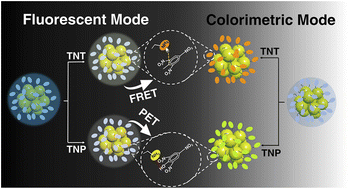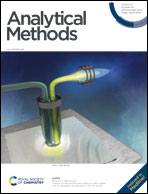Polyethyleneimine-capped copper nanoclusters for detection and discrimination of 2,4,6-trinitrotoluene and 2,4,6-trinitrophenol†
Abstract
The detection and discrimination of 2,4,6-trinitrotoluene (TNT) and 2,4,6-trinitrophenol (TNP) from analogues are of great importance to global security and are full of challenges in the field of trace sensing. Here, benefitting from the strong electrophilicity of TNT, a sensing strategy is established by synthesizing polyethyleneimine capped copper nanoclusters (PEI-Cu NCs) with abundant –NH2 groups. By carefully controlling the size and structure of PEI-Cu NCs, Förster resonance energy transfer (FRET) from PEI-Cu NCs to the Meisenheimer complex occurs resulting from their spectral overlap when detecting TNT, while, due to the energy level match of TNP with PEI-Cu NCs, as well as the strong affinity between its –OH and –NH2 in PEI-Cu NCs, photo-induced electron transfer (PET) is feasibly expected. As a result, TNT and TNP could be detected from 26 types of analogues and cations with a limit of detection (LOD) of 26.57 and 12.82 nM, respectively. Besides, owing to the brown color of the Meisenheimer complex, the discrimination of TNT and TNP could be additionally realized by colorimetric detection. We expect that the proposed methodology would not only shine light on the detection and discrimination of TNT and TNP that mitigate against public security concerns, but also pave a way for the deep understanding of FRET and PET related fluorescence quenching mechanisms from the aspect of controllable sensing material design and synthesis.

- This article is part of the themed collection: Analytical Methods HOT Articles 2022


 Please wait while we load your content...
Please wait while we load your content...